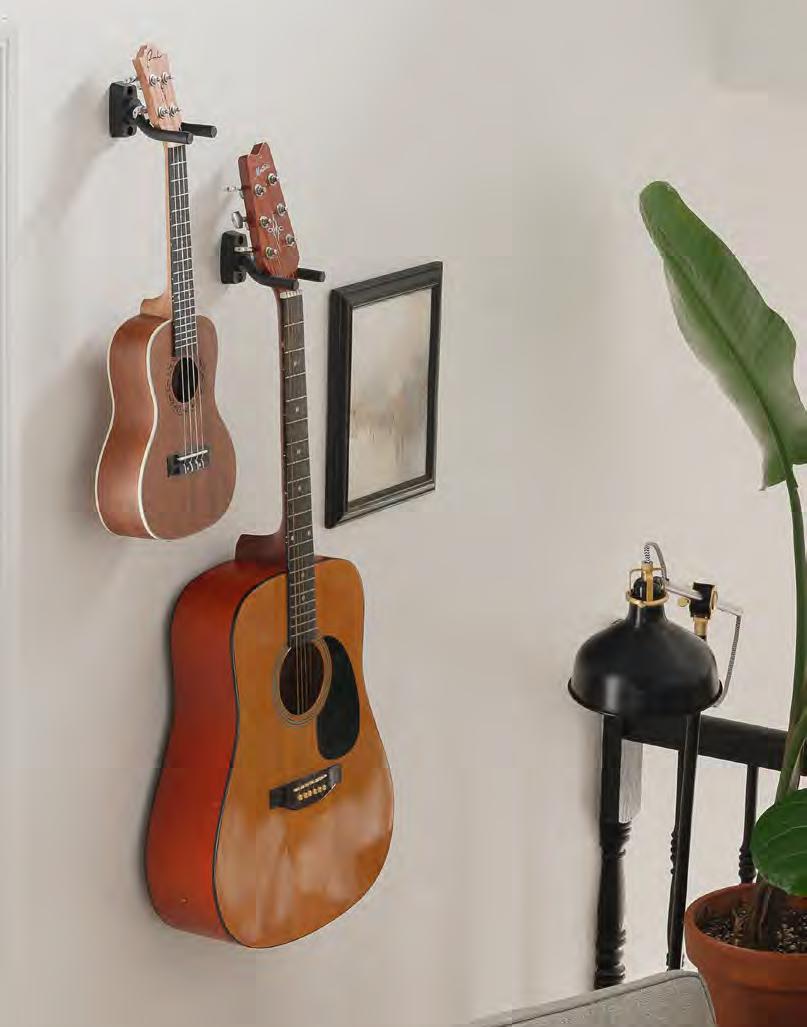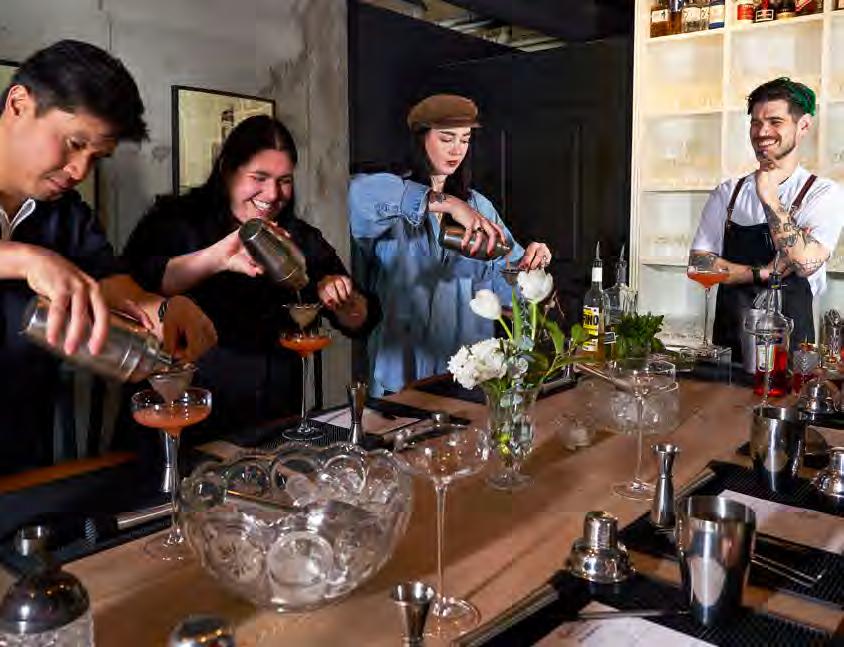

Unleash Your Summer Spirit with Audi
Enjoy unparalleled comfort and cutting-edge technology as you explore new destinations. Adventure awaits this summer with Audi.












Enjoy unparalleled comfort and cutting-edge technology as you explore new destinations. Adventure awaits this summer with Audi.
















 PHOTO BY MARK HOLLERON
PHOTO BY MARK HOLLERON
“Find a group of people who challenge and inspire you, spend a lot of time with them, and it will change your life.”
— AMY POEHLER
In March 2005, Paula Roy asked if she could interview me for Ottawa At Home magazine. “Sure,” I said, although admittedly, I hadn’t heard of the publication. Finding myself on the cover was a bit of a thrill, and I continued to pay attention to the magazine, seeing friends and local businesses I frequented on the pages.
In 2009, Korey Kealey sent me a job description for the magazine’s editorin-chief, “You’d be perfect for this,” she said. And, I’ll admit, I was perfect for it. The job was perfect for me, too. I would go on to buy the publication and spend 15 years running it and turning it into Ottawa’s premiere lifestyle and décor magazine, but I didn’t do this alone. A dynamic group of creators, combined with Jennifer Tackaberry’s tenacious zest for client relations, has resulted in a successful product. We have had a lot of fun along the way.
Often, I’m asked if it’s hard to find content, and my answer is a resounding “Nope.” This city never disappoints. The stories flow from talented designers to innovative restaurants, local businesses, and spirited people. It isn’t for lack of content that we are retiring the print product for Ottawa At Home
I always maintained that I would do this job until I was 60. I’m 60 now, and the time to move on feels right. I end my career on a high note, never once resenting the effort it takes to assemble the pages.
Yes, I will miss being a part of the Ottawa community through my involvement with the magazine. But, for everything, there is a season. If you follow me on social media, you will know that I also write fiction and have secured a literary agent, intending to become a traditionally published author. I am now, officially, a full-time writer.
Thank you, Ottawa, for providing the dynamic content that allowed us to produce an outstanding publication with each issue. It has been a privilege to play a role in showcasing all that this city has to offer. And thank you to the Ottawa At Home team, past and present. I am forever grateful to each of you.
To Ottawa, with love,






HOW TO
DISGRACEFULLY by Clare
Pooley| out June 11th
When Lydia takes a job running a Senior Citizen’s Social Club, she assumes she’ll be spending her time drinking tea and playing cards, she is wrong…
I HOPE THIS FINDS YOU WELL by
Natalie SueA funny, heart-warming office comedy about an admin worker who accidentally gains access to colleagues’ private emails and DMs and uses this intel to save her job.
ROMANCE by Annabel Monaghan | out June 4th
Newly single mom Ali, needs to make her life messier, but there’s no harm in a bit of summer romance. Is there?
LULA DEAN’S LITTLE LIBRARY OF BANNED BOOKS by Kirsten Miller | out June 18th
An entertaining satire about a small southern town battling over banned books, and the little lending library that changes everything.
WE USED TO LIVE HERE by Marcus
KliewerThings go terribly wrong when a family claiming prior ownership shows up at the new home a young couple recently purchased.
ROAD by Sarah
Leipciger| out August 20th
A couple rediscover their grief-broken relationship on a road trip across Canada.
instagram @maryktaggart

Join the #marysmustread book club by signing up for my newsletter at marytaggart.com

EDITOR-IN-CHIEF
Mary Taggart
DESIGN & LAYOUT
AN Design Communications
ASSOCIATE & WEB EDITOR
Olivia Taggart
FOOD EDITOR
Paula Roy
FOOD CONTRIBUTOR
Korey Kealey
STYLE/BEAUTY CONTRIBUTOR
Melissa Shabinsky
CONTRIBUTORS
Sonia Bouwman, Jordann Brown, Mary Ciancibello, Catherine Clark, Sandy Connell, Mark Holleron, Hollie Grace James, Rochelle James, Justin Van Leeuwen, Tia Macpherson, Charlie Senack, Ted Simpson
PROOF READER
Paula Roy
ADVERTISING
Jennifer Tackaberry jtackaberry@ottawaathome.ca
ADMINISTRATION
David Lindsay
FINANCE MANAGER
Danial Taggart
PUBLISHER
Mary Taggart
PUBLISHED BY Ottawa At Home Media Inc.
CONTACT US General inquiries: editor@ottawaathome.ca
DIRECTOR OF NEWSSTAND
Craig Sweetman
FINAL ISSUE
OTTAWA AT HOME MEDIA INC.
Contents © 2024. Reproduction of advertisements or articles appearing in Ottawa At Home, in whole or in part, is forbidden without the written permission of the publisher. Ottawa At Home and Ottawa At Home Media Inc. shall not be liable for slight changes or typographical errors that do not lessen the value of an advertisement. The publisher’s liability for other errors or omissions in connection with any advertisement is strictly limited to publication of the advertisement in any subsequent issue or the refund of any monies paid for the advertisement.

In 2005, Mary Taggart graced the cover of one of Ottawa At Home’s early issues in a piece inviting readers to go window shopping with ‘Ottawa’s decorating diva.’ She’s since branched out to become a novelist and the publisher and editor-in-chief of this magazine. Still, her roots as a trained interior decorator remain strong, as does her conviction that home decor should be fun.
In the previously-mentioned article, Mary emphasized that “decorating shouldn’t be stressful — it should bring joy, both in the process of choosing items and in enjoying your home.” Those words still ring true for her today, as evidenced when we take a peek at how she has chosen to refresh her own spaces.
Located in the heart of Ottawa’s Wellington Village, the Taggart’s current house was built in 2009 for a busy family with four children. Once Mary and her husband, Chris, became empty nesters a few years ago, they opted to redo their kitchen and adjoining family room to reflect their current tastes and needs.
Mary says the space is their primary living area due to its warmth and comfort. “Everything happens here — including much of my working time — except for the holidays, when we use the living and dining rooms.”
She explains that the refreshed décor reflects their love of casual entertaining and the joy of having grandkids. It is a little more elegant and contemporary than the previous iteration, with clean lines and an emphasis on balancing aesthetics and functionality.
Her redecorating objectives were clear, she notes. “I wanted to elevate the furnishings with sturdy yet still comfortable pieces, which is why I chose velvet sofas. It’s a super durable fabric, and the tufting adds a note of elegance.”
Mary has always been a fan of ‘anchoring’ fabrics for large pieces of furniture; these are hues and patterns that can easily be accessorized to add pops of colour or texture as desired. Her new sofas in an understated marine blue achieve that goal. “The shade is soft enough


to blend with darker and lighter colours throughout the space,” confirms Mary, giving a nod to the room’s multihued, eco-friendly silk carpet made from recycled saris.
The kitchen redesign was intended to offer a more sophisticated feel. The sleek and clean look is thanks to gorgeous custom detailing suggested by designer Lorin Russell, with whom Mary collaborated on the design; the work was executed by Muskoka Kitchens, with white marble countertops from Urban Quarry. She wanted glass fronts for the upper cabinets, and Lorin suggested incorporating brass accent lines in the glass and the marble over the stove. Rocky Mountain cabinet hardware in brass from Preston Hardware adds another touch of visual interest, and the cone-shaped light fixtures echo the theme while mimicking the angular profile of the expansive island.
“This is very much an entertaining space as well as one for everyday use,” notes Mary. “Gone is the homework station vibe — we now have just two barstools at the island, and they get a lot of use. Plus, our eight-seater
round table in the kitchen is ideal for friends or family to gather for meals.”
Mary likes how the mood in this part of the house changes with the seasons, particularly in summer when activity extends outdoors into the patio and pool. “Overall, the space is an absolute reflection of my personality, and I’ve decorated it to show that I like whimsical, elegant, playful, and practical things. My favourite décor element is the family room’s gallery wall featuring local pieces.”
The nearby mudroom was refreshed as well, repurposing space previously intended for kids’ backpacks and boots to allow more room for Gilligan, their adorable miniature golden doodle.
Mary stated in 2005, "Good decorating involves patience and an appreciation of quality. Don’t feel like you must complete your new look quickly.” She feels the same today. “I still believe in not buying something just to fill a space. Leave it empty until you find the right thing that makes sense and delights you.”

"Don’t select things to impress other people — choose for yourself and try to work elements of your own personality into your home. If you do, you’ll love the results.”
— Mary Taggart

Because a home should always reflect who you are, Mary urges people not to be timid about expressing themselves through their décor. Similarly, she notes that it’s important to honour where you are in life, and just as you are evolving, so should your home. “Discovering what works now might come easier when you are not trying to juggle the demands of a family versus what will please you.”
Mary remains steadfast in her previous advice that when it comes to décor, your choices should make you happy. She offers the same advice as years ago: "Don’t select things to impress other people — choose for yourself and try to work elements of your own personality into your home. If you do, you’ll love the results.”










From modern towns and golf course residences to boutique condos and a versatile Duo series, eQ Homes continues to be Ottawa’s builder of choice.

To find the home for you, visit eQHomes.ca Join the thousands of families who have proudly said, “I choose eQ Homes.”



W(hen realtors Korey and Liam Kealey, partners with RE/MAX Hallmark Realty Group, built their McKellar Park home, their thought process centered on the lifestyle of a busy family of five. A large kitchen with an attached butler's pantry separated the family living area from the more formal living room and dining room to create joined yet separate spaces.
The backyard, with an entertaining area and pool, enhanced the overall experience, offering the active family plenty of options to live together while feeling like there was enough room to spread out or even get away.
“Who needs a cottage when you can relax and unwind right out your back door?” asks Liam. He offers advice for others considering adding a pool: “Think about
lounging space, including comfortable seating areas for larger gatherings, and remember to consider the need to fence the pool itself if young children come on the scene.”
Within the well-thought-out living spaces, the Kealeys' young-adult children easily entertain friends while Korey and Liam host dinner parties. As an avid cook, Korey is known for making impressive meals for a crowd. Their kitchen showcases an oversized island with enough depth to divide the sink and work area from the seating, so while she’s prepping, guests sit in front, and Korey is part of the conversation, too.
“I like the idea of separate entertaining spaces for adults and kids. The walk-through butler's pantry is the best,” enthuses Korey. The bonus room offers extra

"I spend so much time in the kitchen that my sightline is important. I have to be looking out at the yard or the family room where the kids and Liam are so that I feel like I am part of the action while being productive." —
Korey Kealey
storage for tools, appliances, and dried pantry goods. “It has proven to be a highly desirable spot to hang out while entertaining. It also allows division and connection between the formal dining and living area and the family room. We have comfortably had three social gatherings all at once,” claims Korey.
As the author of The Ultimate Cookbook for Hockey Families and a highly regarded TV food personality, the kitchen is a high priority for Korey as well as her children, who share their mother’s culinary talents. “I spend so much time in the kitchen that my sightline is important. I have to be looking out at the yard or the family room where the kids and Liam are so that I feel like I am part of the action while being productive,” explains Korey.
While they loved their new home, it wasn’t long before Korey and Liam realized their children, having left home shortly after they built, weren’t necessarily using mom and dad’s space to entertain friends. This
left the Kealey’s with a house designed for an active family at a time when their family was busy elsewhere. So, with that in mind, they put the place up for sale.
Selling a home built to the specifics of a lifestyle can be challenging. Luckily for the Kealeys, the needs they built for would be high on the priority list for other families.
“Today, families look for as many lifestyle benefits as possible from their homes. Having a pool means they have a three-season retreat. A gym means they don’t have to leave the house to exercise, and large entertaining spaces never go out of style,” confirmes Liam.
While most people don’t build with the idea that they aren’t creating a long-term home, Korey advises that it’s always good to have re-sale potential in mind. "Enlisting design help ensures you get what you want while the finished product will have broad appeal to others.” This is a crucial element for resale value. A home with too much personalization can make it difficult for buyers to imagine themselves within the space.
1.
Do a walk-through video of the exterior and interior, starting at the front door, to get a feel for how the flow and spaces translate on camera.
2.
3.
Make a room-by-room task list of what needs to be accomplished to make each space feel open, clean, and de-personalized. Start with the items you can see in each room before heading into closets, and it will feel less overwhelming.
Remove all artwork and wall hangings. Group them by colours, themes, and sizes and carefully set them aside. This allows for furniture placement to represent the space best. Once furniture is arranged, select the best artwork to re-install. Note: sometimes, nothing is better.
4. 5.
"Stage" your home. If possible, use your own furniture and interesting personal items. China, crystal, artwork, collectables, and books can be re-imagined to show the personality and warmth of your home.
Make repairs, paint, and clean. Bring in professionals if necessary.








When Laura and Randy Blondin decided to move to the quaint village of Manotick a decade ago, they knew they would eventually look for a renovation challenge with a view. In 2020, they settled on a single-storey bungalow on a one-acre waterfront property just minutes from the Main Street.
“What we found intriguing about this place was watching boats go by, offering a very peaceful feeling when you’re in the backyard. We decided to buy it knowing we’d need extensive renovations,” explains Laura
Laura, who works as a manager in the federal government, designed the home's backyard. What was once a poorly maintained, overgrown area has become an oasis. At its heart is a 22 by 40-foot pool surrounded by a stamped concrete patio and plant-filled ceramic pots. A large composite deck that includes a gazebo and dining area extends over 60 feet to the back of the house, where there is also a hot tub.
“What we wanted to accomplish was to create outdoor living spaces where we could entertain friends and family during the warmer months," offers Laura. “We built two retaining walls out of armour stone, and then down near the water, we have the dock for boats. We also have a dock where we sit on Adirondack chairs grouped around a gas fireplace. The various spaces cater to all kinds of activities.”





"I enjoyed the process and learned a lot about home building. We love the result."
— Randy Blondin

The home, built in 1986, is now about 2,500 square feet in size after an addition was put on the back. Laura says she sought “stylish comfort” with open spaces when designing the residence.
“The furniture and the finishing I chose are timeless. They will not go out of style next year as trends change,” she states. “It’s the tool I’m drawn to.”
The classic contemporary style includes a soft black and white kitchen with shaker cabinets and champagne bronze handles. In the center is a 10-foot waterfall quartz island with seating for five. Part of the garage was closed off to be converted into a walk-in pantry, allowing for more storage.
When visitors enter, they are greeted by large windows on all walls that overlook a view of the backyard and Rideau River. The homeowners added an addition that opened up the space to bring in more natural light.
“The previous house had everything blocked off, and you could not see the water,” reveals Randy, who was in charge of overseeing the construction side of things, working with local contractors and suppliers to create their dream home. “Even in the primary bedroom, the windows were maybe four feet wide by three feet high. It was a lot of decision-making, time and effort. I enjoyed the process and learned a lot about home building. We love the result.”
The windows are now eight feet wide by twelve feet high. While the pair don’t have a background in construction, Randy was the general contractor for a previous renovation project the couple did. Laura always had an eye for design and attended the Ontario Design Institute of Canada.
As warmer weather arrives and construction work on the home and backyard is complete, Laura and Randy are excited to show off their design skills by socializing in their remodeled spaces this summer.



 Living BY ROCHELLE JAMES
PHOTOGRAPHY BY JORDANN BROWN
Living BY ROCHELLE JAMES
PHOTOGRAPHY BY JORDANN BROWN
Amanda Klowak and Neil Sinclair have transformed their 1,700-square-foot Manotick townhouse into a showcase of both their professional expertise and personal style. As the founders of NASK Design Co., their home goes beyond aesthetics — it's a living story filled with laughter, memories, and uniquely personal touches. From the moment you step inside, every detail is carefully curated, seamlessly blending their life and work into a space that's not just beautiful but a sanctuary reflecting their shared life.
Amanda’s design journey started in childhood, playing with paint cards and carpet swatches from hardware stores to craft miniature rooms. This early passion has evolved into a sophisticated approach to interior design, where functionality meets aesthetics. "I have a personal interest in spaces that work. So much of what makes good design is how the space functions,” she says. “I believe that interior design needs to reflect how people live and how they want to live.”
Neil’s background as an engineer in the Army and the completion of his MBA bring a unique blend of precision and planning into their work. His transition from military to design work was influenced by a lifetime surrounded by family members' skills in renovations and design. “My parents were both in the military, and we moved around every couple of years,” he explains. “They are both very handy, and with every new house we moved into, they would meticulously renovate it just in time for the next posting and project. I’m happy to say that their passion for design and building is something they’ve passed on to me, and not long after meeting Amanda, we discovered that it was something we shared.”
Their own house is designed to facilitate easy living and spaces that inspire. The townhome, which they moved into in 2020, was chosen for its solid structure and potential for transformation. It was not a 'gut job'



“I believe that interior design needs to reflect how people live and how they want to live.”
— AMANDA KLOWAK
but a project that required vision to infuse a standard builder model with character and warmth plus a bit of a New York apartment feel.
One of their most significant changes was in the kitchen and living area. "We were ambitious in wanting to remove the main load-bearing wall in this area, but the change in the function and feel of the space is powerful," Neil says. This structural alteration not only enhanced the spatial flow but also helped to create a more cohesive environment for entertaining.
The couple's love of music also finds a place in their home. Neil's collection of guitars, a nod to his past as a bass player in a band with his brother and friends, adorns a dedicated corner of their living area. Meanwhile, Amanda, an aspiring ukulele player, keeps her instrument within easy reach, reflecting her growing passion for playing and its presence in their everyday life.
Notably, their design choices extend to speciallyselected decor pieces that combine aesthetics with personal significance. "Some of our favourite pieces in the home are the reclaimed leaded glass windows we repurposed for our upper cabinets in the kitchen," Amanda shares, emphasizing their love for materials that bring warmth and history into their designs.
Other cherished items include the dining room table, a family heirloom that was one of the very first pieces Amanda restored, and a meticulously revamped and reupholstered rocking chair that once belonged to Neil’s great-grandmother. "Reusing, restoring, and refinishing pieces to me is about creating spaces that have stories — stories that are meaningful to you,” Amanda adds. “In our designs, we really try to balance the use of these reclaimed pieces with functionality that can often come from newer pieces.”

Amanda and Neil also value community engagement and local collaboration. Their designs often feature pieces acquired from local artisans and businesses. For example, Manotick Home Hardware and Mountain Granite were just a few of the local companies they relied on regularly in their own home. “It’s important to us to support our community and work with people who understand the local context," Amanda says. “We’re also incredibly lucky because Neil’s brother, Alex, is an amazing artist. Most of the art in our house was done by Alex, and most of the photographs were taken by Neil, who is a talented landscape photographer.”
The couple's approach extends beyond their own home. They bring this same level of care and attention to detail to their clients' projects, ensuring that each space they design is tailored to the needs and preferences of the homeowners. This client-focused methodology allows them to create environments that reflect their clients’ personalities and lifestyles, much like their own home.












Nestled into a quiet Stittsville neighbourhood lies a modern farmhouse retreat that, although hidden to the outsider, bursts with life as the result of Jessica Gosbee’s creative flair for design. Although some may have been intimidated by initial challenges, which included navigating a unique layout, from the moment the designer laid eyes on this project, all she could visualize was untapped potential. Several months later, the newfound space stands as a testament to the transformative power of design. With a seamless amalgamation of creativity and expertise, Jessica was not dissuaded from her goal of reimagining the century home’s modern addition into a sanctuary where rustic

"a sense of nostalgia and simplicity in an increasingly fastpaced world"

charm meets contemporary elegance. With a request from her clients to modernize the very large open blank space without losing its traditional character, Jessica immediately applied her design philosophy, a foundation steeped in a deep understanding of the complex intricacies that make her clients who they are. In this case, that meant incorporating meaningful styling items such as living, breathing greenery for a self-professed ‘plant mom,’ and adding a coffee table book on Italian wine inspired by the homeowners' honeymoon destination.
“I think that's something that I hope to convey, and it's really thoughtful — I've been listening and getting to know people, and we're friends now. The highlight of this job is meeting so many interesting people, and that’s what I love about it.”
Jessica's childhood experiences, having been born and raised in a small community, instilled in her a profound appreciation for the beauty of rural landscapes and the simplicity of farmhouse living.
A transition from a corporate career in the nuclear industry was fueled by a lifelong passion for creating spaces, and her attention to detail and problemsolving qualities have also become hallmarks of her design approach.
For example, although challenges arose initially due to the elongated shape of the galley living room as the result of a central staircase, Jessica strategically incorporated a classic RH leather sofa along the stairs, flanked by occasional chairs to optimize the space. Custom-made checkerboard cubes from Atmosphère & Bois add a rustic and playful touch. However, their

addition remains strategic as well — custom-made to meet pre-specified dimensions, they provide flexibility to the arrangement. When deciding on the colour palette, Jessica drew inspiration from the area rug, incorporating charcoal, cream, terracotta, and dusty blue tones. In an almost seamless transition, but for the sleek slatted bar cabinet marking the boundary, the dining room space materializes. Outfitted with a custom rustic extension table by Atelier Meuble Rustique paired with shaker chairs, the classic look is, again, complemented by modern items such as Crate & Barrel’s bent metal chandelier and a geometric performance rug. Finally, the reading nook, adjacent to the dining area, serves as a versatile space for family gatherings, quiet moments, and post-dinner conversations, making it a well-loved home feature.
When asked about her thoughts on farmhouse style, Jessica deeply appreciates its versatility and timelessness. She attributes its appeal to a sense of nostalgia and simplicity in an increasingly fast-paced world. As people seek refuge from the chaos of modern life, farmhouse style offers a retreat that, much like the design, has evolved to incorporate modern elements, adapting to the changing needs and preferences of contemporary lifestyles. While traditional elements, such as exposed wood beams, will most likely maintain continuity within the design landscape, she believes that there is also room for innovation and creativity and, by incorporating elements such as natural materials, neutral color palettes, and comfortable furnishings, farmhouse design can be tailored to suit a wide range of tastes and preferences, offering endless possibilities for homeowners seeking
an inviting aesthetic. She explains, “I just think that it’s ever-evolving although the farmhouse element has the staying power — that kind of 'kick off your shoes and stay a while' vibe. Though I do think that it’s evolving to incorporate what modern elements are attractive to each person, which could mean more of a Nordic Scandinavian take on it or minimalist take on it, or it could be coastal.”
Finally, when asked about the homeowners' satisfaction with the final result, Jessica beams with pride. She recalls the moment they walked into their newly transformed space — exceeding clients' expectations is the ultimate reward. As they settled into their new home, the farmhouse project became more than just a design endeavour; it has become a place where new memories will be formed and cherished for years to come.

"it has become a place where new memories will be formed and cherished for years to come"




Stefanie Seguin, owner/designer of Twig and Timber Interiors, tackled two very personal projects recently. A primary bedroom for her client embraced Stefanie’s penchant for modern, coastal-inspired design. A new bathroom for her seven-yearold daughter was treated to her mom’s talents with eye-catching results.


A visit to Charleston, South Carolina, swayed Stefanie’s design eye to the soothing calmness of coastal décor. She states, "Whenever I get the chance to go the coastal route, I am all for it.” The bedroom décor offered her this opportunity. Having worked in other spaces of the home, Stefanie knew the client was drawn to the natural materials typically inspired by the airy coastal style. Given that it was a bedroom, Stefanie wanted to create a space that brought calm in the form of a sanctuary for her client.
“Most people want a place to retreat, with calmness in their bedroom. I keep things simple and typically try to stick with light colours and bring in natural materials for texture and the serenity they create,” Stefanie reveals. This bedroom project serves as an ideal example of a tastefully soothing space. When asked for advice, Stefanie maintains good bedding and linens will always be worth the price.
Stefanie’s seven-year-old daughter proved to be one of her easiest clients, given that she believes her mother’s work to be beautiful and handed over the design job for her bathroom with utter confidence. “I think it would have been overwhelming for her to choose things as she really finds beauty in just about everything, and it would have made things stressful for her to make choices,” Stefanie says.
With her client’s confidence, Stefanie chose an Ikea vanity for its cost-effectiveness, which allowed for a splurge on faucet, mirror, and hardware, adding a stylish touch to the space. While she would have loved to have chosen a mosaic floor tile, the practical side got the best of her, and Stefanie went with a porcelain tile — Maverick 12324 in white — for its low maintenance ease.
A relatively simple tub and toilet plus moderately priced shower fixtures kept costs down, allowing for extras like Serena & Lily palmetto (bone) wallpaper,

clear pine v-groove, wood paneling, and dressy hardware. It’s these added details that give the space the wow! factor.
Stefanie was assured that her client was satisfied as she kept a close eye on the process. “She kept popping her head in and saying how beautiful it was. I think I made some good choices for her,” confirms Stefanie.

Elevate your home with premium Miele appliances.
From April 11 – June 26, 2024, enjoy a complimentary industry-leading extended 10 year warranty OR save up to 12% on all Miele Major Domestic Appliances.













































































In the first issue of Ottawa At Home, June 2004, we asked industry professionals what buyers could get for 300K in some of Ottawa’s top neighbourhoods. Twenty years later we asked what to expect around the million mark.
BY TED SIMPSONWith a new LRT extension coming soon to Ottawa’s East end, the neighbourhood of Orleans is in a prime position to take off as a real estate hot spot.
The expansive community is home to every amenity a growing family might need, with no shortage of schools, sports facilities, and entertainment options.
Orleans also plays home to many beautiful natural features like Petrie Island, Bilberry Creek, and the Princess Louise waterfall.
Real estate agent Greg Hamre offers up a stunning family home on River Ridge Crescent. It is a four-bedroom, four-bathroom fully detached with a finished basement and two fireplaces priced at just under one million dollars.
The backyard is like an Italian courtyard with private western exposure. The details of this home are unique in craftsmanship, and the millwork takes you back in time.
Orleans offers the unique opportunity to find a beautiful home nestled away on a quiet street with low congestion while still living within walking distance of shops, parks, restaurants, and future LRT stations.
Hamre says the neighbourhood is not on most home buyers’ radars. However, it has all the charm, convenience, and recreation for families looking for a community to call home. It is a diamond in the rough.
The short west end, as it was originally known, incorporates Westboro, Mckellar Park, and Wellington Village.
All of these neighbourhoods were originally built throughout the twentieth century as working and middle-class enclaves, featuring predominantly single homes surrounded by parks, schools, amenities, and green spaces. The area is known for some of Ottawa’s finest boutique retailers and restaurants.
Over time, as the city grows and neighbourhoods gentrify, the demand for family homes on tree-lined streets inside Ottawa's Greenbelt will only increase, leaving many buyers with little hope of finding an affordable option in the most desired communities.
Fortunately for some, the legendary Ottawa architect David Younghusband saw the need for a scattering of affordable homes throughout the city and, specifically, the short west end.
Real estate agent John Lindsay offers up one of these coveted homes in Wellington West.
The brick building is a semi-detached on Clarendon Avenue, just a few blocks south of Elmdale Public School, with three beds, two baths, an open concept main floor, a finished lower level, a mudroom, deck, a private yard and front stone patio.
This property has been renovated significantly over the past twenty years and comes with a list price of $779,000.
The Glebe, a highly identifiable neighbourhood in Ottawa, is the definition of the term central location, lying smack dab in the middle of the city.
Known for its charm, picturesque residences, well-established greenery, and diverse shopping scene, it boasts a vibrant atmosphere. Bank Street, the
principal thoroughfare of the Glebe, is populated with cafes, pastry shops, chic boutiques, and art galleries and is home to one of the city’s largest events centres in Lansdowne Park.
The Glebe ranks among Ottawa's priciest neighbourhoods, where it's uncommon to find a home or even a plot of land for sale below the million-dollar mark.
Real estate agent Ian Charlebois, who has lived and worked in the Glebe for many years, offers up a rare deal at one million dollars even.
On the serene cul-de-sac of Rosebery Avenue, it is nestled just off Bank Street, near Central Park. This spacious residence boasts three bedrooms, a den, two full bathrooms, and a family room adjacent to the kitchen. With a history dating back to 1954, this home showcases a majestic staircase, lofty ceilings, vintage light fixtures, original woodwork, and abundant character. Its secluded backyard hosts fruit trees, a kitchen deck, and a private driveway accommodating up to 4 vehicles. Offered for sale by its original owner, such unique opportunities come along once in a lifetime.
When you think of Hunt Club, immediate access to the airport (without being on the flight path), good transit, South Keys shopping centre, and the Ottawa Hunt and Golf Club all come to mind.
The area is very multicultural, with great amenities to serve the population including many Middle Eastern and international cuisine restaurants.
The Hunt Club area was established in the early 1970s, and newer homes and neighbourhoods were incorporated into this neighbourhood on an ongoing basis.

Hunt Club Park was established in the mid-80s, and Hunt Club Greenboro plus Upper Hunt Club in the 90s.
Hunt Club is an area in the city's south end where current infrastructure, roads, schools, and amenities have kept up with the growth as the newer neighbourhoods established themselves. The Hunt Club neighbourhoods offer a wide variety of housing styles, including large and modest single-family homes, towns and semis, and many terrace-style homes.
Interested in what a million dollars can buy in the area? Real estate agent Kathy McVeigh offers up a 2600+ square foot, four bedroom, three bathroom, 1996 Richcraft built home with an inground pool and fully finished basement in Hunt Club Park listed for just over one million dollars.
This is great value in a central neighbourhood for a home this size. In the newer neighbourhoods just down Bank Street South, a home with these features would sell for considerably more.




















Barry Hobin believes that success comes from teamwork. The celebrated Ottawa architect, who founded his namesake firm Hobin Architecture 45 years ago, is a passionate former Carleton Ravens football player, so it’s no surprise that he uses a sports metaphor to explain his approach to life: “You can’t win the game alone, you have to be a team player, whether that’s football, running a business, or being involved in the community.”
His team player approach has paid dividends. His firm has grown from one person at its founding to 45 employees today, has earned an international reputation, and has made a lasting physical imprint on Ottawa and beyond. However, the most important thing to Barry is not that he has achieved success but that success has allowed him to give back to his community.
This spring, Barry will receive the Lifetime Design Achievement Award from the Ontario Association of Architects, which, according to the award citation, reflects that he has “spent half a century committed to building a successful practice based on design excellence, workplace equity, creative collaboration, social responsibility and, above all, a sense of belonging to and contributing to a wider community.”
And that last part — about contributing to a broader community — has formed the central axis of Barry’s career. “We have some core values in the firm, and one of those themes is around community — we live in community, we serve community, we encourage community participation,” he says.
“It revolves around the idea that you are not alone, that the gifts you have are not yours exclusively, that they’re very much tied into your role,” he explains.
Barry and his team have supported dozens of charities, including (but certainly not limited to) Matthew House, Cornerstone Housing for Women, Jericho Road, Multifaith Housing, the Salvation Army, The Mission, and BGC Ottawa.
“We do reviews with employees where we challenge them to identify a charity they’d like us to donate to because we’re trying to nurture people into a sense of giving.”
Barry feels this approach is more necessary now than ever, with younger generations taking a more individualistic approach to the world around them and volunteerism suffering because of it.
“We’ve changed from a society where meaning was understood by the group to one where the idea seems to be that I can do whatever I want, I don’t care, I have my own truth,” he observes.
But he is a man of deep and lasting faith and has hope for the future. “I think the first thing is to realize that you are part of a whole,” he emphasizes. “You must be a strong individual, but you must realize that you are part of a greater thing.”
So Barry will continue to combine his faith, his talent, and his commitment to community in support of the many organizations he feels are doing the heavy lifting in society because, from his perspective, “that’s the only way to help build a world that’s better than what we have.”



An alchemist at heart, Steve Morrier had been creating cordials and soda mixers for a while before deciding it was time to open a storefront about a year ago. Split Tree Cocktail offers a wide variety of unique products to make celebrating and commemorating memorable moments. Custom charcuterie boxes, specialty mixers, cocktail recipes, exclusive bar, and glassware and accessories are available at their store in the heart of Westboro. Split Tree also offers workshops and tastings for those interested in experiencing mixology at the next level.
Visit Split Tree Cocktail Co. when hosting your next event at 98 J Richmond Rd or online at splittree.ca

Two friends, Jennifer Miller and Jill Bonk, found themselves at a turning point in their careers and decided it was time to shift gears to partner to open a furniture and lighting store. Jennifer, a designer, and Jill, a home stager, had long talked about what they wished for from high-end designer brands in Ottawa's furniture and lighting industry, and from there, SHOWROOM was born. Despite growing online options for ordering, in their experience, choosing the right furniture for a home is difficult, and most buyers want to see it and feel it before purchasing.
SHOWROOM is located at 1539 Stittsville Main Street.

Blumenstudio simply means flower studio, the cornerstone of German floral designer Katrin Kosk’s craft. Her distinct aesthetic and passion for floral design was apparent in the flower shop and cafe space she opened on Parkdale Avenue in 2011. She moved to an upstairs studio space at 1395 Wellington Street West at the beginning of the pandemic. Over COVID, Kat pivoted her business to focus on the bouquet of the week featuring seasonal flowers from local farms. Her weekly bouquet subscription program remains a customer favourite.
Visit Kat at her studio or contact her at info@ blumenstudio.ca. She is enthusiastic about educating herself and others to cultivate her craft.
Consignment shopping has become a chic way to refresh your wardrobe in a fashion landscape increasingly shaped by eco-conscious consumers and savvy trendsetters.
Consignment boutiques in Ottawa offer a curated selection of unique and designer pieces, making them a haven for fashionistas who know sustainability is no longer just a buzzword but a way of life.



Crystal and resin earrings, The Recollective instagram @shoptherecollective


Celine Platform sandals, The Recollective instagram @shoptherecollective



Petal + Pup dress and Ted Baker purse, @Trovefashion

L’Agence blazer, Red Valentino wide leg jeans and Celine platform sandals from @shoptherecollective
Large tote from @valamode Top from @Trovefashion
All handbags can be found at Valamode.com





 BY MELISSA SHABINSKY instagram @melissashabinsky
BY MELISSA SHABINSKY instagram @melissashabinsky
 JANE DALY
Fragrance creator, writer instagram @dalybeauty
JANE DALY
Fragrance creator, writer instagram @dalybeauty
When asked what makes a perfume iconic, Jane says, “When it becomes the go-to, when anyone thinks of the word perfume. Chanel N°5 is iconic because even if you know nothing about anything in the world of fragrance, Chanel N°5 will be recognized, both in name and probably the bottle.” She also tells us that for a perfume to become iconic, it must smell good to as many people as possible and, in general, make them feel good. “The closest we have to that is the classic and iconic eau de cologne, like 4711. It's been in production since the 1700s, using citruses blended with classic florals like lavender and neroli with invigorating herbs like rosemary. And it still smells timeless,” she states. Jane, who some refer to as the Perfume Whisperer, claims that, “fragrance is about style, not fashion.” So, following trends isn’t necessarily a thing. If you like it, wear it. There will be bonus points if everyone around you likes it, too.
 CHRISTINE SHAIKIN Owner of Justine's Clothing instagram @justinestudio
CHRISTINE SHAIKIN Owner of Justine's Clothing instagram @justinestudio
Christine has dressed some of Canada’s most famous women, including prime ministers' wives, governors general, and ambassadors, and shares that each one of
Ottawa is a robust community in the beauty industry, with highly regarded experts living and working right here in the nation’s capital. No one knows this better than I do, as I’ve been a part of it for over twenty years, creating internationally successful products where the idea grew right here. I asked some past colleagues about standing the test of time in this evolving business.
these impressive women shares the same attributes — grace, elegance, authenticity, ‘plus a little fairy dust.’ “To have true style is to believe in yourself — the combination of the clothing and how one wears/ carries the outfit, acceptance of one's imperfections, and how one plays with the clothing and accessories.”
She believes the clothing is the canvas, and then one can add one's own ‘paint’ and uniqueness with accessories. “It is also important to work with the body's shape — you want to highlight the best parts of yourself.” Christine adds, “It is about being ageless, accepting ourselves with confidence.”
Timeless style “isn’t about labels,” she states. “It is all about classic design, balance & symmetry, pure luxe fabrics, and how one feels in them.”
 Makeup artist instagram @melwatergirl
Makeup artist instagram @melwatergirl
Having spent 25 years in the beauty industry, Melissa admits to having seen her fair share of timeless beauty products. “Like the iconic red lip of Grace Kelly (Dior rouge 999), the launch of Youth Dew by Estée Lauder in 1953, a fragrance my mother wore her entire life.” The list goes on. Iconic beauty is alive and well, but she believes that generations view it differently. “My feelings on the matter at 52 are wildly different than a 22-year-old... but both are valid.”
She offers that for a product to stand out, it needs three things. “It has to deliver on quality; people need to feel and look
their best using it, and finally, do others notice them (this quality is not usually admitted, but it's important).”
With so many celebrity-driven brands, she admits it is hard to break through to create something unique. “To be honest, it is yet to be determined if a cosmetic or cosmetic brand will reach the iconic beauty status of days past. The competition is massive, and with TikTok and Instagram, the market is constantly flooded with the new big thing.”
She loves that beauty has never been better, more inclusive, daring, and fun.
 FIORELLA DINARDO
FIORELLA DINARDO
Co-Owner Salon Fiorella's instagram @salonfiorella instagram @fiorella_lola
For one of Ottawa’s busiest salon owners, Fiorella has seen hairstyles change dramatically over the decades. “One of the biggest changes in the last 20 years in the hair industry has to be colour and hair extensions. We have gone from chunky foil highlights to soft balayage, shadowed roots, and creative colour. The possibilities now are endless.”
With so many techniques, iconic Hollywood glam has become attainable to everyone. “ Imagine the day has come when we as stylists can ask, ”Would you like your hair longer or shorter today?”
She says that the Kardashians are one of many driving forces in the global industry and that they have brought glamour back. Hence, she sees many clients booking standing appointments for blowouts and makeup applications. “Glamour is back again, and it is so fabulous.”
Michael Curran is best known around town as the Ottawa Business Journal publisher. Still, that title doesn’t even describe the depth of work he has undertaken for the city's local business community and print media.
Michael also played a starring role in the lore of Ottawa At Home, having been one of the key figures behind its creation 20 years ago.
The entrepreneurial spirit defining his work has been with Michael since his earliest days in the media business. Coming out of Carleton University’s journalism school in the early 90s, he was cutting his teeth at the Orleans Star community newspaper but was quickly consumed by an undeniable ambition that he could build a better newspaper on his own.
“I was so displeased with how they were running things, and I was so cocky and arrogant that I got together with the sales manager and we left,” says Michael. “We raised a quarter million dollars from local investors, borrowed another quarter million dollars from the bank, and started our own weekly newspaper to compete against the Star.”
East-end readers will know that the Orleans Star still exists to this day, and Michael's startup paper does not. Ambition can only go so far, as the new paper quickly burned through their cash reserves in too much of a rush to compete. “We were completely naive, just so naive,” says Michael, shaking his head and smiling as he recalls those early days.
But he managed to exit unscathed by selling the business off to a national chain called Transcontinental (TC) Media.
This was how Michael found himself interviewing for the role of editor at the Ottawa Business Journal (OBJ). It was the late 90s and was when Michael first met his now longtime business partner, Mark Sutcliffe, who you might recognize as the current Mayor of Ottawa. Mark hired Michael, and they had massive ambitions to turn the business journal into a media powerhouse.
This was quickly followed by a series of unfortunate events. First the dot-com bubble burst, then 9/11 happened and the revenue taps dried up. OBJ managed to survive, however, by selling itself to the same TC Media group that bought Michael's failing Orleans newspaper.
This time, Michael stayed on at TC as a regional manager for the Ottawa area and continued overseeing the OBJ and a collection of community papers. The economy started bouncing back, and opportunities began to arise for new publications to join the company's lineup. Ottawa At Home was born.

In 2004, a talented businesswoman named Caroline Andrews set the wheels in motion to create a new magazine. Michael remembers Caroline as having an absolute passion for homes, food, and lifestyle. Ottawa At Home magazine (OAH) went into publication with pages reflecting all those things and more. OAH was doing well as a passion project, but Caroline was quickly promoted to a new role with TC Media in Toronto, leaving Michael in search of a new leader for the magazine.
“I still remember Mary coming into the boardroom that day, and there’s this fascinating contradiction taking place,” recalls Michael. “She’s saying, ‘I’m not a professional writer, I’m not an editor, I don’t know how to run a magazine’... But she was very confident at the same time. She was a doer. We thought she could do anything she put her mind to.”
Michael remembers watching Mary quickly take a somewhat muddled passion project and sharpen it into a much more precise vision of what the magazine needed to be — refining the business plan and honing the content to a point that perfectly understands the niche and the reader of the publication.
“At the end of the day, it just takes someone who can make things happen,” says Michael. “That was Mary Taggart.”
Not long after this transition, another financial crisis gripped the world, publishing revenues dried up again, and TC Media found themselves in yet another precarious situation. This is where Michael's journey comes full circle, and he teamed up with Mark Sutcliffe to found their own company, Great River Media. Now, they can buy the Ottawa Business Journal and take Ottawa at Home under their wing.
Of course, not long after this, the industry is shaken up yet again. Social media dominates traditional publishing; everyone is pivoting to video-based content. “We needed to get sharper and more focused to execute better on the potential around OBJ,” says Michael. “Well, obviously, Mary’s the natural new owner of Ottawa at Home.”
So, in 2015, the magazine changed hands for the last time, and Michael found that everything ended up exactly where it was always supposed to be.
“Mary just hit a home run with the magazine,” he says. “It’s just been wonderful to see the product mature over time, and I can’t believe, quite frankly, that it’s been 20 years already; it blows my mind.”






 BY KOREY KEALEY
HOLLERON
BY KOREY KEALEY
HOLLERON

Affogato (meaning “drowned” in Italian) is a coffee-based dessert, which is made with just three ingredients — espresso, gelato, and a shot of liqueur (optional)
KOREY’S TIPS:
Line a baking tray with parchment. Scoop ice cream into ¼ cup-sized balls; cover and freeze until ready to serve. Allow 2 scoops per person.
Find vanilla gelato at Farinella on Booth Street. High-quality vanilla ice cream works well too.
Serve with biscotti or Italian ladyfingers for dipping.
Prep time: 5 minutes
Serves: 1
INGREDIENTS
2 scoops vanilla gelato or ice cream
1 shot espresso
1 tbsp coffee liqueur (optional)
Optional garnish: grated dark chocolate, crushed hazelnut or pistachios
INSTRUCTIONS
1. Brew an espresso.
2. Place scoops of vanilla gelato or ice cream in a wide serving glass or bowl.
3. Pour over a shot of espresso.
4. Optional: Pour 1 tbsp coffee liqueur then top with grated dark chocolate and/or crushed nuts.
5. Serve with a spoon.


In keeping with Ottawa At Home’s 20th-anniversary issue, we’re paying tribute to several perennially popular Ottawa-area restaurants that have similarly been thriving for twenty or more years.

Stephen Beckta’s first Ottawa restaurant opened in 2003 on Nepean Street, relocating to Elgin Street in 2014. Beckta 2.0 offers intimate white-tablecloth fine dining areas, various private dining spaces, and a casual wine bar boasting an Art Deco feel. The cuisine is modern and fresh, emphasizing local ingredients with international influences.
Stephen believes their continued success stems from an unwavering focus on hospitality. “This means caring not only for guests — using food and wine as tools to make people feel amazing — but also staff, suppliers, community, and finally the bottom line.” He confirms that after twenty years and having opened two more successful restaurants, working service and connecting with guests and staff still makes him happy.
As for the local food scene, Beckta notes that there is now a big concentration of amazing restaurants here, whereas twenty-one years ago, you could name the greats on one hand. “Fine dining has also gotten much more casual,” he adds. “I used to wear a suit and tie during service, but people are much more relaxed now, so I dress correspondingly.”
At Beckta, innovations such as adding a plant-based tasting menu have been extremely positive, generating huge interest, not just among vegans. As for the future, Stephen shares that they have some exciting things that revolve around extending that culture of caring to a new industry starting in 2024-2025.
Absinthe Café opened on Holland Avenue in 2003, with chef-owner Patrick Garland moving it a few years later to Wellington Street West. One of the restaurant’s appeals is its laid-back vibe, with midcentury décor influences and a determinedly ‘unstuffy’ atmosphere. The food perfectly complements the space, relying on locally sourced ingredients prepared inventively and sophisticatedly, using classic French culinary techniques to offer elevated comfort food.

Patrick attributes Absinthe’s continued success to consistency, humility, rolling with the punches, and having an excellent team focused on hospitality. “Our motto is “from the people, for the people,” referring first to the people who craft our food and our invaluable local suppliers,” explains Patrick. “ ‘For the people’ reflects our guests, staff, and community; without these passionate people, we would not be here today.”
Patrick says the local culinary scene has evolved in favour of more chef-owned establishments making amazing food. “Restaurants are not so Eurocentric anymore; cuisine comes from all four corners of the globe, not just France and Italy,” he notes. “More casual dining is on the rise, and similarly, wines are much more approachable and fun, with amazing and affordable ones being made just a couple of hundred kilometres from Ottawa. The same applies to farmers, cheesemakers, and more. Our guests are far more wine and food-savvy now and don’t mind being challenged.”
Chef Joe Thottungal opened Coconut Lagoon on St. Laurent Boulevard in 2004. A devastating fire in 2020 led to the restaurant’s reimagining, rebuilding, and reopening in 2022. Having begun as what Joe describes as a ‘hole in the wall,’ Coconut Lagoon now boasts high ceilings and gorgeous décor, making it both elegant and approachable while offering the finest cuisine inspired by India’s Kerala region.
“Our success is thanks to having a good team — including the same chef — since the beginning, which also allows me to do other things like charity work, writing two cookbooks, and opening Thali, my second restaurant,” he says. “We served a menu which differed from other Indian restaurants in Ottawa plus focused on community engagement. After about eight to ten years of hard work, Coconut Lagoon had become an institution, helped by the diplomatic corps and people who love to travel. Being part of people’s celebrations is an honour, and we never take this lightly.”
He notes that a big change he has seen is the proliferation of ethnic food, citing Burmese and Peruvian as just two of many locally available cuisines. He also cites the newer emphasis on locally sourced, sustainable ingredients, food waste, and food security. “Those issues were not on the table before, but we are very conscious about them now, and we are innovating by making our kitchen an experimental place with our Chef’s tables and collaborations.”
 PHOTO BY JEANNE KELLY-GUILLEN
PHOTO BY JEANNE KELLY-GUILLEN

Les Fougères opened in 1993 after owners Charles Part and Jennifer Warren-Part found an idyllic rural setting near Chelsea. It’s now home to a celebrated restaurant, gourmet food shop, food production facility, lush gardens, and an upstairs art gallery. A 2016 renovation created an airy, cleanlined dining room with expansive views out into nature, helping the space, like the menus, express a strong sense of place and seasonality. Les Fougères has always celebrated the beautiful power of the table, and success has followed.
Jennifer and Charles directly praise their trusted and talented team and “the many partner farmers, foragers, beekeepers, cheese makers, and other suppliers who make it possible to showcase great ingredients.” They thank their loyal neighborhood supporters and guests from the region and beyond who continue to inspire them.
They recall that in 1993, fine dining shifted from primarily French cuisine and hushed white linen service towards a fresh look at the varied Canadian culinary experience. A growing interest in local and organic ingredients, supported by a farm-to-table ethos and the beginning of the ‘nose to tail’ approach, marked a dynamic and exciting time in the industry.
While they love their work, Charles and Jennifer acknowledge they are beginning to think about future adventures. They will soon be on the hunt for someone else to take their property and business into its next beautiful chapter.
Located in the ByWard Market, Restaurant E18hteen opened in 2001 and quickly became known for its elegant ambiance and upscale dining experience.
The décor combines modern and classic elements in a chic and comfortable setting, with cuisine highlighting the finest Canadian ingredients meshed with global inspiration. Its culinary team continually challenges creative boundaries, experimenting with unique combinations, cultural fusion, molecular gastronomy, and interesting local, seasonal ingredients. Collaborations with international chefs have been hugely popular.
Caroline Gosselin, owner of the E18hteen Hospitality Group, believes sustained success comes from a commitment to quality in both service and cuisine. “Consistently offering a stylish and inviting atmosphere, combined with a diverse menu featuring well-executed, high-quality dishes, creates a memorable and reliable dining experience,” she says. “Adapting to evolving culinary trends is inspiring and contributes to the restaurant’s popularity, creating a loyal customer base.”
She notes that the changes to the local restaurant scene have been shifts toward sustainability, locally sourced ingredients, and more inclusive menus that accommodate various dietary preferences. As for the future of E18hteen, she feels gastronomy is an art form that reflects the times, including the impact of global events, societal shifts, and design trends. “These factors, as well as a focus on the environment, inclusivity, diversity, and technological advancements, will likely play larger roles for us in the future of our menu development, growing our produce and personalizing the customer experience.”

Craftsmanship, the key to quality, is derived from consistently creating with passion, care, and unwavering attention to detail and is the heart of every project undertaken by Lev Design Build. The firm’s owners, Samuel Laplante and Rebecca Garvey, have decades of combined professional experience; she is a designer, and he is a builder.
Their teamwork ensures a smooth client relationship. “Our communication is constant, which means that Rebecca’s designs are reviewed and revised if needed before clients see them, certifying they will translate well into the building stage,” confirms Samuel.
“We have a unique ability to understand and connect with our clients, which facilitates creating the home of their dreams,” says Rebecca. “We get to know them, understand their personalities, and how they envision living in their space, leading to complete satisfaction at the end of each project.”
A full-service firm, Lev Design Build handles all aspects of every project, from design to construction and project management. Everything handled in-house provides a superior experience for the client, making it exciting and stress-free. Their pricing model is comprehensive, accurate, and transparent, so there will be no surprises during construction.

“We have a unique ability to understand and connect with our clients, which facilitates creating the home of their dreams,”
Rebecca
“We are down to earth, loyal, trustworthy, and extremely approachable. Like many of them, clients appreciate that we are also parents and dog owners, so we know how to make spaces that are functional and durable,” offers Rebecca.
Samuel notes that they seek to create extraordinary homes. “Our goal is to consistently create spaces with an unmistakable wow factor, and nothing makes us happier than when clients tell us they feel like their home now belongs in a magazine. Every day, we are mindful of maintaining our reputation as an outstanding design-build firm and of delivering the elevated quality our clients have come to expect from us.”





When Ottawa At Home first featured chef Marc Lepine, he was a 'new kid on the block' in our autumn 2008 issue. He’s been a part of the Ottawa food scene for over 20 years. He is celebrated as the only two-time Canadian culinary champion, was named Canada's most innovative chef in 2018 and twice recognized as ‘Ottawa Chef of the Year’ by the Canadian Culinary Federation.
How and when did you get your start in the restaurant industry?
I started working in a hotel kitchen in my hometown of Kincardine during high school and went on to study culinary management at Canadore College in North Bay. I pursued another year of studies at George Brown College in Toronto, which involved an internship in Italy. I moved to Ottawa in 2001 to complete the sommelier program at Algonquin while also working at the Courtyard Restaurant in the ByWard market.
You knew more than 20 years ago that you wanted to open your own restaurant. Did you envision a place like Atelier?
The concept at the heart of Atelier was formed during my time at Courtyard. I was interested in modernist cuisine and inspired by molecular gastronomy pioneer Grant Achatz at Alinea in Chicago. I wanted a smaller space that offered just one experiential tasting menu and had this vision of what I wanted my kitchen to look like in terms of its setup with new and innovative technology.
What drew you to Rochester Street versus some of the more established culinary districts?
I looked at fifteen places before I landed on Rochester. Much like Beckta’s original location on Nepean Street, I felt Atelier could become a destination place. Bonuses included the backyard garden, which I was eager to cultivate, plus ample parking in the area.
In what ways do you feel the Ottawa food industry has evolved over the past two decades?
When I first arrived, there were a lot of celebrated French restaurants throughout the region, but that’s not the case so
much now. Ottawa was one of the pioneers in the chef-driven restaurant movement, and things here are constantly changing. Now, we have lots of smaller spots, each with their own style. How has consumer demand shifted, and how have you responded to that?
It is our job as chefs to educate people. We have to navigate the changing trends. At Atelier, our guests have varying levels of knowledge of food, and we enjoy taking them on a journey and showing them what we can do. It’s particularly fun to serve people who are really open to the experience.
Have your successes on the national stage made a significant impact on your work?
When I first started, I was told, “Every little bit helps.” I think the national championships have had a positive impact and have validated that we know what we are doing. Since we opened, our clientele has been more than 50% out-of-towners, but we got more local traffic after the championships.
What have you enjoyed about playing a key part in mentoring current and future culinary stars?
Our unique kitchen setup and menu help attract some very talented people. It’s been fun to see chefs like Jason Sawison of Stofa and Briana Kim (a fellow Canadian culinary champion who will be opening a new spot called Antheia this year) move on and have success. We’ve had so many other great people here, like Adam Ghor at Stolen Goods, pastry chef Michael Holland, and Jakob Lutes, chef/owner of Port City Royal in Saint John, to name just a few. Our kitchen's current level of talent is similarly impressive and gives me a sense of pride and happiness that I can be a part of that.
What would you wish to be doing if you weren't a chef? Something where I can be creative and use my hands and my mind. But I can’t imagine a future outside of the industry at this point. Do you have any advice for chefs looking to open their own restaurants?
Stay true to your vision and get through the dark days of the opening years of people getting to know you. It’s all worth it in the end.



When I first prepared a shrimp and melon recipe for the spring 2015 edition of Ottawa At Home, it was a plated salad reflective of the flavour profile that appealed to me at that time. Just as our region’s food scene has evolved, so too has my palate. I find myself gravitating frequently towards Asian-inspired dishes, thanks in part to the fact that it’s become much easier to find specialty ingredients in mainstream food shops in Ottawa.
15 medium-sized shrimp, fresh or frozen (unpeeled)
2 tablespoons (30 mL) freshly-squeezed lime juice
2 teaspoons (10 mL) fish sauce
1 clove garlic, finely minced
½ teaspoon (3.25 g) sriracha or other hot sauce
¼ ripe honeydew melon
15 ripe cherry tomatoes
1 tablespoon (8 g) very finely chopped peanuts (optional)
Handful of fresh mint leaves, finely minced

 RECIPE & PHOT0
BY PAULA ROY instagram X @paulajroy
RECIPE & PHOT0
BY PAULA ROY instagram X @paulajroy
Keep up with Paula's culinary creations at constantlycooking.com
1. Bring a small pot of water to a boil and add shrimp. Cook for about 3 minutes (slightly longer if cooking from frozen) until they turn pink and have curled up.
2. Remove shrimp from the pot and transfer to a bowl of ice water. Let cool.
3. While shrimp cools, whisk the lime juice, fish sauce, garlic, and sriracha together in a broad, shallow bowl. Set aside.
4. Peel the cooked shrimp, discarding the shells; add to the lime juice mixture and toss gently to thoroughly coat shrimp. Refrigerate while you prepare the melon.
5. Cut the melon into ½ inch (1.25 cm) thick slices. Remove seeds and trim rind off melon. Cut into 1/2 inch (1.25) pieces.
6. With a slotted spoon, transfer the marinated shrimp to a small bowl. Add melon to the lime mixture and toss gently to coat. Let sit 5 minutes.
7. While melon is marinating, thread one shrimp onto each of the 15 skewers. Add a melon cube and a cherry tomato to each skewer and place them all on a platter.
8. Chill until ready to serve. Just before serving, sprinkle the skewers with finely chopped peanuts and mint.
Makes 15 portions.


























































































